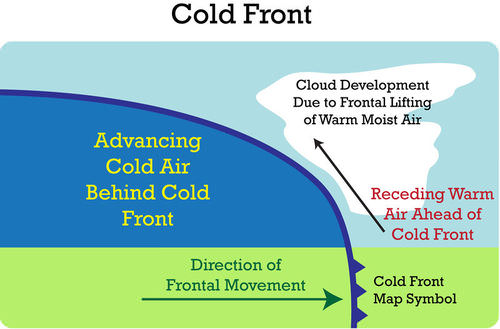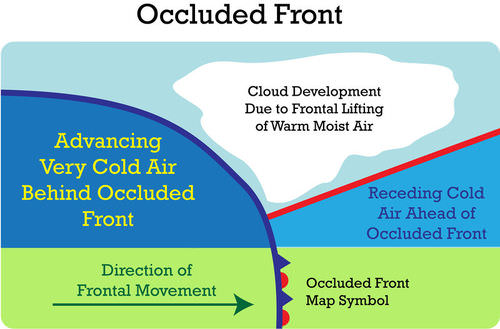11.7方面
章节大纲
-
Lesson
::经验教训What happens when one air mass meets another?
::当一个空气质量遇到另一个空气质量时会怎么样?This sight is common when one meets another. You can almost see one air mass being pushed up over the other. When two air masses meet, the result is often a storm . Have you been to the Midwestern United States in the spring? This is a common sight.
::这种景象在彼此相遇时是常见的。 你几乎可以看到一个气团被推过另一个气团。 当两个气团相遇时,结果往往是一场风暴。 春天你去过美国中西部吗? 这是一个常见的景象。Fronts
::前线The boundary between two air masses of different temperatures is called a front . Air masses usually don’t mix at a front. The differences in and pressure cause and . Types of fronts include cold, warm, occluded, and stationary fronts .
::两种不同温度的空气质量之间的界限被称为前沿。 空气质量通常不会在前沿混杂。 压力原因和压力原因的差异。 前线的类型包括寒冷、温暖、隐蔽和固定的前沿。Cold Fronts
::冷面阵线A cold front forms when a cold air mass runs into a warm air mass ( Figure ). At a cold front, the cold air mass is moving faster than the warm air mass. The cold air mass lifts the warm air mass out of its way. As the warm air rises, its water vapor condenses. Clouds form, and precipitation falls. If the warm air is very humid, precipitation can be heavy. Temperature and pressure differences between the two air masses cause winds . Winds may be very strong along a cold front.
::当寒冷的空气质量进入温暖的空气质量(图 ) 时, 寒冷的前方形式是寒冷的空气质量(图 ) 。 在寒冷的表面, 冷冷的空气质量的移动速度快于温暖的空气质量。 寒冷的空气质量将温暖的空气质量抬离它的道路。 随着温暖的空气的上升, 水蒸气的凝结, 云层形成, 降水量下降。 如果温暖的空气非常潮湿, 降水量会很大。 两个空气质量之间的温度和压力差异会引起风。 风在寒冷的前面可能非常强烈。Cold fronts often bring stormy weather. As the fast-moving cold air mass keeps advancing, so does the cold front. Cold fronts often bring sudden changes in the . There may be a thin line of storms right at the front that moves as it moves. In the spring and summer, the storms may be and . In the late fall and winter, the storms may bring snow . After a cold front passes, the cold air mass behind it brings cooler temperatures. The air is likely to be less humid as well. Can you explain why?
::随着快速移动的寒冷空气质量的不断推进,寒冷的战线也随之而来。冷冷的战线常常带来突变。 前面的暴风雨可能随风而行。 在春季和夏季,暴风雨可能会发生。 在秋冬末, 暴风可能会带来雪。 在寒冷的战线过后, 寒冷的战线会带来更冷的温度。 空气也可能较不潮湿。 你能解释为什么吗 ?Warm Fronts
::暖热阵线When a warm air mass runs into a cold air mass, it creates a warm front ( Figure ). The warm air mass is moving faster than the cold air mass. The warm air mass then flows up over the cold air mass. As the warm air rises, it cools. This brings about clouds and sometimes light precipitation. Warm fronts move slowly and cover a wide area. After a warm front passes, the warm air mass behind it brings warmer temperatures. The warm air is also likely to be more humid.
::当温暖的空气质量进入冷空气质量时,它会创造温暖的正面(图 )。温暖的空气质量比冷空气质量移动得更快。温暖的空气质量随后在冷空气质量上流动。随着温暖的空气上升,它会冷却。这会产生云,有时会轻降水。温暖的表面移动缓慢,覆盖大面积。温暖的前方经过后,温暖的空气质量会带来更温暖的温度。温暖的空气也可能更潮湿。Warm fronts generally bring cloudy weather. Occluded Fronts
::隐蔽前线With an occluded front , a warm air mass becomes trapped between two cold air masses. The warm air is lifted up above the cold air ( Figure ). Cloudy weather and precipitation along the front are typical.
::随着隐蔽的正面,温暖的空气质量被困在两个寒冷的空气中。温暖的空气被升到冷空气之上(图 ) 。 云雾般的天气和沿前方的降水是典型的。How does an occluded front differ from a warm or cold front? Stationary Fronts
::固定阵线Sometimes two air masses stop moving when they meet. These stalled air masses create a stationary front . Such a front may bring clouds and precipitation to the same area for many days.
::有时,两个空气质量在相遇时停止移动。 这些停滞的空气质量创造了一个固定的战线。 这样的战线可能会将云层和降水带到同一个地区很多天。Summary
::摘要- Much of the weather occurs at fronts, where air masses meet.
::大部分天气发生在空气质量相交的前线。
- In a warm front, a warm air mass slides over a cold air mass. In a cold front, a cold air mass slides under a warm air mass.
::在一个温暖的正面,一个温暖的空气质量滑动在寒冷的空气质量之上。在寒冷的正面,一个冷空气质量滑动在温暖的空气质量之下。
- An occluded front has three air masses: cold, warm, and cold.
::隐蔽的前线有三个气团:冷、热、冷。
Review
::回顾- What characteristics give warm fronts and cold fronts their names?
::什么样的特点能给温暖的战线和寒冷的战线取名?
- Describe a warm front. What weather is found with a warm front?
::描述一个温暖的防线。什么天气是温暖的防线?
- Describe a cold front. What weather is found with a cold front?
::描述一下寒冷的防线 冷冷的防线是什么样的天气?
- How does an occluded front form?
::隐蔽的前方如何形成?
Explore More
::探索更多Use the resource below to answer the questions that follow.
::利用以下资源回答以下问题。- What is a front?
::什么是前线?
- How does a cold front form?
::寒冷的正面如何形成?
- What forms along a cold front?
::在寒冷的战线上是什么形式?
- How does a warm front form?
::温暖的前线如何形成?
- What type of clouds form at warm fronts?
::在温暖的战线形成什么样的云?
- What type of precipitation is produced from a warm front?
::温暖的战线会产生哪类降水?
- What is a stationary front?
::什么是固定的前线?
- What type of weather can occur at an occluded front?
::隐蔽前线可发生何种天气?
- Much of the weather occurs at fronts, where air masses meet.



